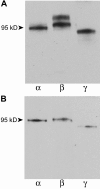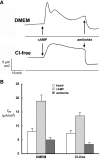cAMP increases density of ENaC subunits in the apical membrane of MDCK cells in direct proportion to amiloride-sensitive Na(+) transport
- PMID: 12084777
- PMCID: PMC2311399
- DOI: 10.1085/jgp.20018547
cAMP increases density of ENaC subunits in the apical membrane of MDCK cells in direct proportion to amiloride-sensitive Na(+) transport
Abstract
Antidiuretic hormone and/or cAMP increase Na(+) transport in the rat renal collecting duct and similar epithelia, including Madin-Darby canine kidney (MDCK) cell monolayers grown in culture. This study was undertaken to determine if that increment in Na(+) transport could be explained quantitatively by an increased density of ENaC Na(+) channels in the apical membrane. MDCK cells with no endogenous ENaC expression were retrovirally transfected with rat alpha-, beta-, and gammaENaC subunits, each of which were labeled with the FLAG epitope in their extracellular loop as described previously (Firsov, D., L. Schild, I. Gautschi, A.-M. Mérillat, E. Schneeberger, and B.C. Rossier. 1996. PROC: Natl. Acad. Sci. USA. 93:15370-15375). The density of ENaC subunits was quantified by specific binding of (125)I-labeled anti-FLAG antibody (M2) to the apical membrane, which was found to be a saturable function of M2 concentration with half-maximal binding at 4-8 nM. Transepithelial Na(+) transport was measured as the amiloride-sensitive short-circuit current (AS-I(sc)) across MDCK cells grown on permeable supports. Specific M2 binding was positively correlated with AS-I(sc) measured in the same experiments. Stimulation with cAMP (20 microM 8-p-chlorothio-cAMP plus 200 microM IBMX) significantly increased AS-I(sc) from 11.2 +/- 1.3 to 18.1 +/- 1.3 microA/cm(2). M2 binding (at 1.7 nM M2) increased in direct proportion to AS-I(sc) from 0.62 +/- 0.13 to 1.16 +/- 0.18 fmol/cm(2). Based on the concentration dependence of M2 binding, the quantity of Na(+) channels per unit of AS-I(sc) was calculated to be the same in the presence and absence of cAMP, 0.23 +/- 0.04 and 0.21 +/-0.05 fmol/microA, respectively. These values would be consistent with a single channel conductance of approximately 5 pS (typically reported for ENaC channels) only if the open probability is <0.02, i.e., less than one-tenth of the typical value. We interpret the proportional increases in binding and AS-I(sc) to indicate that the increased density of ENaC subunits in the apical membrane can account completely for the I(sc) increase produced by cAMP.
Figures







Similar articles
-
Inhibition of ENaC by intracellular Cl- in an MDCK clone with high ENaC expression.Am J Physiol Renal Physiol. 2004 Oct;287(4):F722-31. doi: 10.1152/ajprenal.00135.2004. Epub 2004 May 25. Am J Physiol Renal Physiol. 2004. PMID: 15161604
-
Prostaglandin E2 stimulates sodium reabsorption in MDCK C7 cells, a renal collecting duct principal cell model.Prostaglandins Leukot Essent Fatty Acids. 2003 Nov;69(5):315-22. doi: 10.1016/j.plefa.2003.06.002. Prostaglandins Leukot Essent Fatty Acids. 2003. PMID: 14580365
-
Electrophysiological characterization of the rat epithelial Na+ channel (rENaC) expressed in MDCK cells. Effects of Na+ and Ca2+.J Gen Physiol. 1998 Jun;111(6):825-46. doi: 10.1085/jgp.111.6.825. J Gen Physiol. 1998. PMID: 9607939 Free PMC article.
-
Regulation of epithelial sodium channels by the ubiquitin-proteasome proteolytic pathway.Am J Physiol Renal Physiol. 2006 Jun;290(6):F1285-94. doi: 10.1152/ajprenal.00432.2005. Am J Physiol Renal Physiol. 2006. PMID: 16682484 Review.
-
Sodium-dependent copper uptake across epithelia: a review of rationale with experimental evidence from gill and intestine.Biochim Biophys Acta. 2002 Nov 13;1566(1-2):104-15. doi: 10.1016/s0005-2736(02)00590-4. Biochim Biophys Acta. 2002. PMID: 12421542 Review.
Cited by
-
Adenylyl cyclase VI mediates vasopressin-stimulated ENaC activity.J Am Soc Nephrol. 2013 Feb;24(2):218-27. doi: 10.1681/ASN.2012050449. Epub 2012 Dec 20. J Am Soc Nephrol. 2013. PMID: 23264685 Free PMC article.
-
Lack of an effect of collecting duct-specific deletion of adenylyl cyclase 3 on renal Na+ and water excretion or arterial pressure.Am J Physiol Renal Physiol. 2014 Mar 15;306(6):F597-607. doi: 10.1152/ajprenal.00505.2013. Epub 2014 Jan 15. Am J Physiol Renal Physiol. 2014. PMID: 24431204 Free PMC article.
-
Small heat shock protein alphaA-crystallin regulates epithelial sodium channel expression.J Biol Chem. 2007 Sep 21;282(38):28149-56. doi: 10.1074/jbc.M703409200. Epub 2007 Jul 30. J Biol Chem. 2007. PMID: 17664274 Free PMC article.
-
Activation of the epithelial Na+ channel in the collecting duct by vasopressin contributes to water reabsorption.Am J Physiol Renal Physiol. 2009 Nov;297(5):F1411-8. doi: 10.1152/ajprenal.00371.2009. Epub 2009 Aug 19. Am J Physiol Renal Physiol. 2009. PMID: 19692483 Free PMC article.
-
Regulation of the epithelial sodium channel by membrane trafficking.Am J Physiol Renal Physiol. 2009 Jan;296(1):F10-24. doi: 10.1152/ajprenal.90248.2008. Epub 2008 May 28. Am J Physiol Renal Physiol. 2009. PMID: 18508877 Free PMC article. Review.
References
-
- Berdiev, B.K., A.G. Prat, H.F. Cantiello, D.A. Ausiello, C.M. Fuller, B. Jovov, D.J. Benos, and I.I. Ismailov. 1996. Regulation of epithelial sodium channels by short actin filaments. J. Biol. Chem. 271:17704–17710. - PubMed
-
- Bindels, R.J.M., J.A. Schafer, and M.C. Reif. 1988. Stimulation of sodium transport by aldosterone and arginine vasotocin in A6 cells. Biochim. Biophys. Acta. 972:320–330. - PubMed
-
- Blazer-Yost, B.L., and S.I. Helman. 1997. The amiloride-sensitive epithelial Na+ channel: binding sites and channel densities. Am. J. Physiol. 272:C761–C769. - PubMed
-
- Bradford, A.L., I.I. Ismailov, J.M. Achard, D.G. Warnock, J.K. Bubien, and D.J. Benos. 1995. Immunopurification and functional reconstitution of a Na+ channel complex from rat lymphocytes. Am. J. Physiol. 269:C601–C611. - PubMed
Publication types
MeSH terms
Substances
Grants and funding
LinkOut - more resources
Full Text Sources
Research Materials

